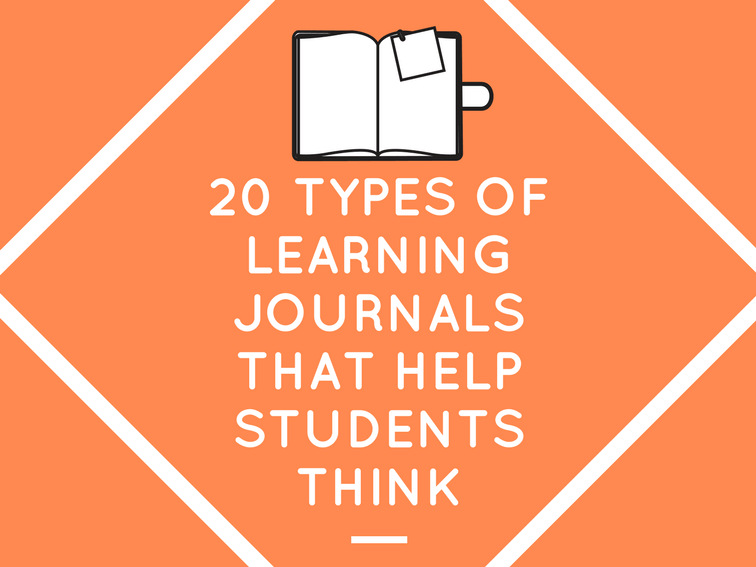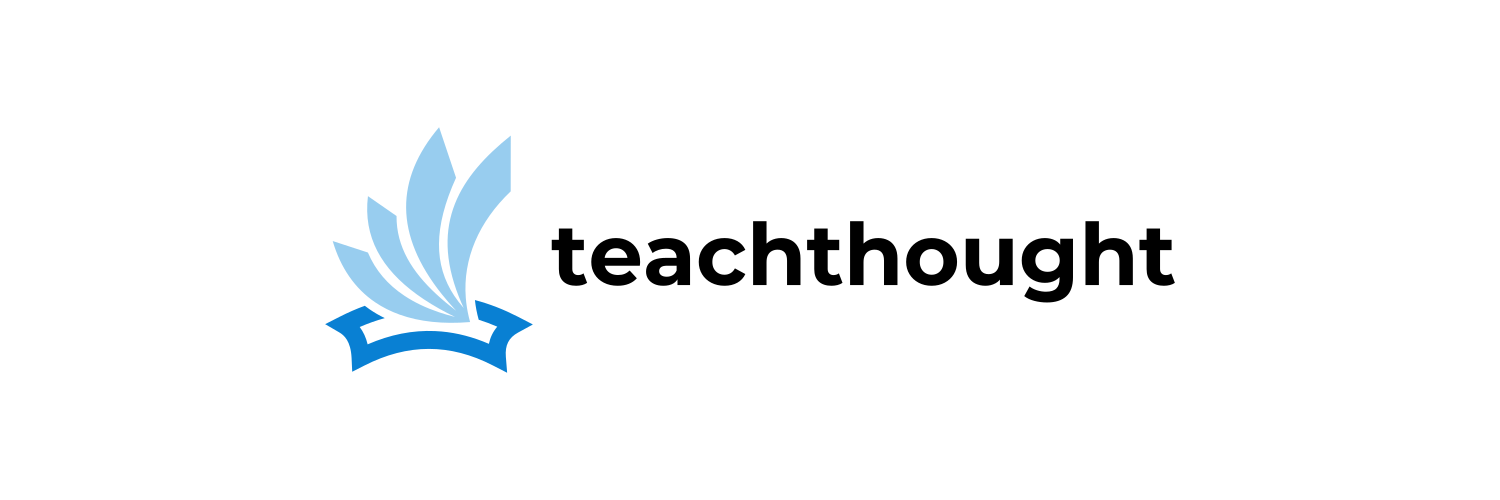20 Types Of Learning Journals That Help Students Think
A learning journal is an ongoing collection of writing done for the purpose of learning rather than the purpose of demonstrating learning.

Learning Journals Are Great Tools To Help Students Think
by Terry Heick
What is a learning journal?
A learning journal is simply an ongoing collection of writing for learning–that is, writing done for the purpose of learning rather than the purpose of demonstrating learning.
Learning journals are often named for a specific purpose and/or format–a creative writing journal, for example. Even a personal blog is a kind of journal, and can thus become a learning journal if the blogging is done in order to promote, deepen, or extend learning of some kind.
There are as many types of learning journals as there are ways to think, mainly because writing is a powerful strategy for both documenting and promoting thinking. Below are 20 types of learning journals–in this case, learning journals that promote thinking.
Of course, it is slightly redundant to specific writing that promotes thinking because writing is simply the manifestation of thinking. All writing, to some degree, requires thinking. However, the types of learning journals listed below have been chosen for their particular talent in helping students think.
Note, there’s no reason you can’t combine many types of journals into one, thinking of journal types like categories on a website or sections of a magazine. This would be especially beneficial for younger writers who may easily tire–and thus not benefit from–a pure Transfer Journal.
You can also use this approach to personalize learning for students. If you know one student may benefit from sketch notes and ‘I wonder…’ journaling while another may be more inclined towards metacognition and connecting, by all means, adapt the journal to the student and not the other way around.
20 Types Of Learning Journals That Help Students Think
1. Question Journal: This type of journal is focused on inquiry–the asking and refinement of questions. They can be answered or merely ‘wondered about.’ The big idea here is students asking and improving their own questions. The QFT Strategy could be useful here.
2. Metacognitive Journal: A journal focused on thinking about thinking. In a Metacognitive Journal, students write about their thinking–their tendencies, changes in their thinking over time, cognitive blind spots, etc.
3. Change Journal: All learning should result in personal and social change. Similar to the ‘change in thinking’ topic in the Metacognitive Journal listened above, a ‘Change Journal’ frames the writing for learning in terms of, well, change.
How has their knowledge changed after a lesson or project–how it is now more complete or useful, for example? Change in their own behavior as the result of their learning is another possible approach. That is, how is or should their own inclinations or skills or general potential different post-discussion/lesson/project/unit. Writers can also reflect on how other knowledge (about other topics, for example) as changed after encountering new data or ‘finishing’ a learning experience of some kind.
4. Connecting Journal: A learning journal that frames writing through the connections between things. For example, in science, this could be writing about how new knowledge about the scientific process connects to old perceptions. Or, less abstractly, learners could simply write about how the scientific process connects to data, business, technology, or science itself at large.
A Connecting Journal, more than anything else, requires writers to make, focus on, or otherwise frame their thinking through connections. In this way, it pairs well with a ‘Sketch Note’ Journal, which would allow students to make those connections through prose as well as drawings or concept maps.
5. Transfer Journal: A journal that focuses on learners transferring their learning–to new and unfamiliar circumstances in the strictest sense. If a student learns about migration in social studies, a Transfer Journal would allow them to consider how that knowledge might be used, or how it might transfer to current events, for example.
It could also focus on transfer from within the classroom to outside the classroom, making explicit the learner’s application of academic and content knowledge in their own lives.
6. ‘I wonder…’ Journal: A learning journal similar to the Question Journal, the ‘I wonder…’ journal would likely feature less detailed and more imaginative entries based on student wondering and musing.
‘I wonder…if Pythagoras based his theory on something he had recently learned himself?’
‘I wonder…if literary symbolism is what makes hip-hop so powerful, or if it’s more wordplay and ‘sounds?’
‘I wonder…how often Tesla shocked himself?’
7. ‘I notice/I think…’ Journal:
8. Visualization Journal: A type of learning journal that promoted acute and specific visualization of learning, knowledge, etc. This could be students creating visual metaphors for the function of something they’ve just learned–the revision stage of the writing process, for example.
In a Visualization Journal, a student would create a visual metaphor or analogy about how the revision stage functions–what it ‘does.’ One response might be students drawing construction workers renovating a building–changing drywall or painting the outside of a home a new color. This would distinguish it from the editing stage of the writing process, which includes more minor changes often based on language conventions. A suitable visualization for editing might be someone redecorating a room.
9. Doodle Journal: A type of learning journal that is similar to ‘I wonder…’ in its disarming form. Here, students merely doodle about their learning/learning experience, with no requirement other than being able to explain why they drew what they drew. This can be useful for hesitant writers who also believe they ‘can’t draw.’
Anyone can doodle.
10. Concept/Example Journal: A type of learning journal that promotes thinking through concepts (abstract) or thinking through examples (concrete). Learning about gravity in science class? Learners can write about gravity as a kind of concept, especially in relation to other concepts–momentum or centrifugal force, for example. (This is similar to the Connection Journal.)
But they can also simply write about examples of gravity, which is more visible, immediate, and ‘easier’ for learners with emerging knowledge.
11. 5 Ws Journal: A journal framed through the iconic 5 Ws: Who/What/Where/Why/When
Civil Rights? Who was for and against Civil Rights? What was the most impactful event in this history of the Civil Rights era in the United States? Where in the world today is Civil Rights a critical issue? And so on.
Students can combine this approach with the Question Journal and focus on asking the questions, or consider the ‘I wonder…’ approach and ‘wonder’ about possible responses to ‘5 W questions’ the teacher creates–and do so without the worry of being ‘wrong,’ which makes learning journals fantastic assessment tools.
12. Private Journal: A type of learning journal private only to the student, and only requiring that the student writing something about learning. It can be about their own experience learning, or their confidence or other emotion before/during/after the lesson.
13: Digital Journal: Any of the above, but stored digitally. This doesn’t have to be ‘published,’ either. There is a strong push for all student work to ‘leave the building,’ but that couldn’t be further from the truth. Much of learning–especially reflections and journaling–is necessarily private. Whether you and the students decide that the learning should be published or not, you can still take advantage of digital tools to store, organize, share privately, and curate learning to write activities from any type of learning journal.
Below, University of Missouri-St. Louis details seven additional types of research-based learning journals to consider in your classroom.
7 Research-Based Learning Journals
‘A note about reflection journals: A common tendency is for journal entries to become a mere log of events rather than a reflective activity in which students consider the service experience in the context of learning objectives. Guidance is needed to help students link personal learning with course content.
1. Personal Journal: Students will write freely about their experience. This is usually done weekly. These personal journals may be submitted periodically to the instructor, or kept as a reference to use at the end of the experience when putting together an academic essay reflecting their experience. (Hatcher 1996)
2. Dialogue Journal: Students submit loose-leaf pages from a dialogue journal bi-weekly (or otherwise at appropriate intervals) for the instructor to read and comment on. While labor intensive for the instructor, this can provide continual feedback to students and prompt new questions for students to consider during the semester. (Goldsmith, 1995)
3. Highlighted Journal: Before students submit the reflective journal, they reread personal entries and, using a highlighter, mark sections of the journal that directly relate to concepts discussed in the text or in class. This makes it easier for the instructor to identify the student to reflect on their experience in light of course content. (Gary Hesser, Augsberg College )
4. Key Phrase Journal: In this type of journal, students are asked to integrate terms and key phrases within their journal entries. The instructor can provide a list of terms at the beginning of the semester or for a certain portion of the text. Students could also create their own list of key phrases to include. Journal entries are written within the framework of the course content and become an observation of how course content is evident in the service experience. (Hatcher 1996)
5. Double-entry Journal: When using a double-entry journal, students are asked to write one-page entries each week: Students describe their personal thoughts and reactions to the service experience on the left page of the journal, and write about key issues from class discussions or readings on the right page of the journal. Students then draw arrows indicating relationships between their personal experiences and course content. This type of journal is a compilation of personal data and a summary of course content in preparation of a more formal reflection paper at the end of the semester. (Angelo and Cross 1993)
6. Critical Incident Journal: This type of journal entry focuses the student on analysis of a particular event that occurred during the week. By answering one of the following sets of prompts, students are asked to consider their thoughts and reactions and articulate the action they plan to take in the future: Describe a significant event that occurred as a part of the service-learning experience. Why was this significant to you? What underlying issues (societal, interpersonal) surfaced as a result of this experience? How will this incident influence your future behavior? Another set of questions for a critical incident journal includes the following prompts: Describe an incident or situation that created a dilemma for you in terms of what to say or do. What is the first thing you thought of to say or do? List three other actions you might have taken. Which of the above seems best to you now and why do you think this is the best response? (Hatcher 1996)
7. Three-part Journal: Students are asked to divide each page of their journal into thirds, and write weekly entries during the semester. In the top section, students describe some aspect of the service experience. In the middle of the page, they are asked to analyze how course content relates to the service experience. And finally, an application section prompts students to comment on how the experience and course content can be applied to their personal or professional life. (Bringle 1996)’
